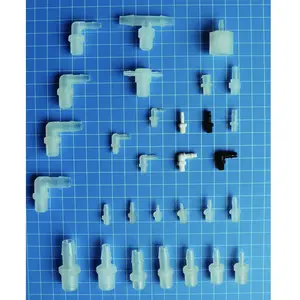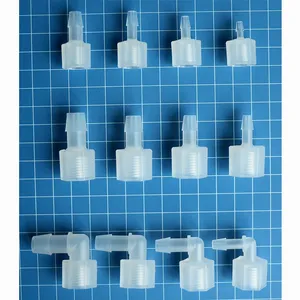
All categories
Featured selections
Trade Assurance
Buyer Central
Help Center
Get the app
Become a supplier

(3888 products available)


























The type of pipe fittings p trap is determined by the plumbing materials used, the trap's configuration, and where the plumbing goes. Grasping these fitting types makes it easier to handle plumbing tasks efficiently.
Compression p traps are easy to install and do not require welding or soldering. They have threaded connections secured with a compression nut, inwardly forcing the washer against the pipe. This metal washer creates a firm, leak-proof seal.
Commonly employed with PVC, copper, and plastic pipes, compression p traps work well where frequent adjustments are needed, such as in places requiring easy maintenance.
Waste p traps are installed beneath sinks in drains, designed to gather waste water. Unlike other traps, which may be found in kitchen and bathroom installations, waste p traps serve a unique function capturing debris before it clogs the main plumbing lines. They are accessible for cleaning.
Commonly made from PVC or metal, waste p traps trap style may vary from siphon traps to bottle traps, depending on space and preferences. For example, bottle traps are suitable for tight spaces because they have a compact, cylindrical, bottle-shaped design, while siphon traps have a more intricate shape that helps with better water siphoning.
PTP trap, also known as p trap plumbing, is a plumbing fixture that maintains a small puddle of water through the trap's shape. Its primary role is to block sewer gases from entering living areas. Every type of plumbing will need at least one P trap installed somewhere along the line. Look at some examples:
Pipe fittings p traps can be made of metal, plastic, and other materials. Each has pros and cons intended for different applications.
PVC, or polyvinyl chloride, is the most commonly used material for creating P traps, especially in modern plumbing systems. Due to its synthetic polymer plastic nature, PVC is corrosion-resistant, durable, and easy to work with.
Features like low cost, lightweight, and the ease of installing provide additional advantages. Unfortunately, PVC can degrade over time due to exposure to sunlight, limiting usage for places where it will be in direct light.
Stainless steel is often preferred for its strength, non-corrosive property, and excellent resistance to rust, especially in high-moisture environments like bathrooms and kitchens. In terms of durability, stainless steel holds up well in both residential and commercial settings. While costlier than other metals, stainless steel is aesthetically appealing and does not easily dent or scratch.
This makes it ideal for decorative plumbing fixtures.
Brass is a durable copper-zinc alloy commonly utilized in p traps. Over time, it has endured due to its strength and resistance to corrosion, tarnishing, and rust, making it suitable for damp, high-humidity environments like bathrooms and basements.
In terms of strength, it withstands wear and tear, thus finding applications in high-traffic areas.
Chrome-plated metal is applied to waste fittings, zurn fittings, sink traps, and repair clamps to realize a sleek, shiny finish over low- to high-grade steel or other metals. This plating, where the underlying metal may be either brass or steel, makes it suitable for aesthetics and adds corrosion resistance for better durability.
Frequently found in residential and commercial bathrooms and kitchens, chrome-plated p traps integrate easily with other plumbing fixtures.
Pipe fittings p traps are commercially popular due to their increasing demand for plumbing, construction, and property maintenance across industrial, residential, and commercial sectors.
Popular plumbing fixtures like radiator covers, bathroom sinks, shower drains, and kitchen sinks, help eliminate waste or even protect against blockage and sewer gases. Constant installation, repair, and maintenance of these traps call for durable fittings compatible with varying plumbing systems.
P traps are used to install, replace, and maintain plumbing systems in construction and renovation projects. These traps ensure the plumbing codes are satisfied in residential and commercial sectors like hotels, offices, industrial plants, and apartments.
Even in property maintenance, P traps require constant monitoring and replacement for efficient plumbing system functionality. Traps often face issues like clogging, corrosion, and wear. Having the right u trap, s trap, or any other handy may come in clutch.
Accessibility is paramount for commercial buyers, so they source p traps in bulk from reliable manufacturers, ensuring their plumbing needs are met consistently at cost-effective prices. P traps are thus supplied worldwide by wholesalers and distributors in plumbing supply stores, hardware outlets, and online platforms catering to their diverse clientele, ranging from individual plumbers to large contracting firms.
The only surefire way to ensure smooth operations in commercial settings is to make the right supply decisions, and that begins with understanding concrete and practical factors when choosing p trap fittings.
A1: Stainless steel or PVC are the best materials for outdoor P traps due to their resistance to corrosion. The elements will not easily degrade them, making them ideal for long-lasting durability in harsh weather conditions.
A2: Bottle traps have a more compact, cylindrical shape. However, conventional p traps, like s traps, are U or s shaped, conserving more water and keeping sewer gases away.
A3: The size of a P trap depends on the drain diameter. For an effective installation, the trap's outlet should match the drain pipe diameter to ensure proper waste water flow with minimal backups or blockages.
A4: P traps should be checked once a month in commercial settings to prevent clogging or overexposed sewer gases. This frequent check ensures all plumbing hardware operates optimally.
A5: Signs of a failing p trap include slow drainage, gurgling sounds, and sewer smells. Other signs are visible leaks or even water stains under the trap, frequent clogging, and air bubbles in the waste water.